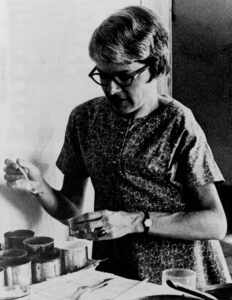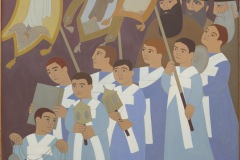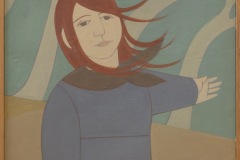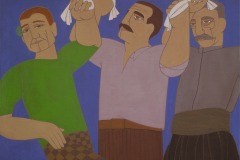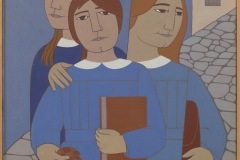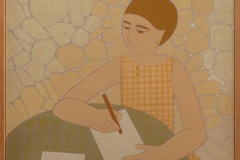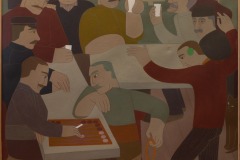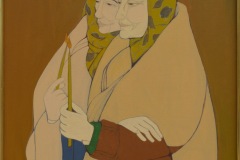“Where there is love of man, there is love of art.”
~Hippocrates
On the island of Lesbos, a young woman from Rhode Island found her destiny. Marguerite “Peggy” Frances Sylvia learned to paint and captured the rhythm of life among her friends and neighbors in the seaside village of Molivos.
The Hellenic-American Cultural Center proudly serves as curators of the paintings of Marguerite Frances Sylvia through the generosity of her friends Bobby and John Maslen.
Peggy’s paintings capture scenes from everyday life in a specific village on a particular Greek island. Yet, the experiences are common to villages throughout both the islands and mainland Greece. The images of priests and bishops, Orthodox services, processions and holidays, weddings, Greek folk dancers, kafenions, families with yiayias (grandmothers) and papous (grandfathers), mothers and children, worry beads, tavernas and bouzouki bands, are all genuinely Pan-Hellenic.
Born in July 1928, the artist was abandoned at birth. She was a victim of severe scoliosis, a condition she bore with grace all her life. Her first years were a painful blur of moving from hospital to foster homes one after another, always returning to the hospital. When she was eight years old and close to losing her struggle to live, she was placed in a loving home with a mother, father, and slightly older sister. Together they gave her the love and care that saved her life.
The little girl, called Peggy by her family and friends, sailed happily through her schooling that began in the first grade when she was eight years old. Very soon her intelligence, sense of humor, developing love of music and art overshadowed her small body. Much later a friend wrote, “. . . her essence of spirit came toward one.”
She graduated from Rhode Island School of Design in 1952 with her roommate Bobby Lynn Hartness and their friend John Maslen. Peggy and Bobby moved to New York and soon found success designing children’s clothing. Bobby and John married in 1955 moving to Portland but remaining Peggy’s lifelong friends and ultimately caretakers of her art.
By 1958, Peggy had saved enough money to move to London and a new job designing clothes for children. She loved to travel, and one of her many journeys brought her to the island of Lesbos and the village of Molivos. At the age of 34, she decided to go home to London, save all her money and return to this village. Leaving behind her career, her flat and her friends possibly to paint, possibly to write, Peggy planned to give herself three years to discover her path.
In her first letter from Molivos to Bobby Maslen dated October 21, 1962, Peggy wrote:
“My house here is full of treasures, rich in memories, and they make up for the lack of furniture. The view is even more breathtaking than from last summer’s house, for I look out across garden-farms and olive trees of the valley to the mauve mountains beyond and out to the sea as well. I have a roof garden over the kitchen and plan to have lovely potted roses and irises this spring. From this private perch the sunsets are truly magnificent. How I wish you could see my beautiful island and crazy-charming house. I have almost nothing and almost everything!”
When summer came, Peggy met new friends who heard about her attempts at painting.
“There are two Canadian couples here . . . the men, painters. . . they are willing to teach me the chemistry of paint mixing, canvas stretching, etc.”
They told her to have stretcher bars made by the local carpenters. Then, they took her to the fabric store in the larger town of Myteline to buy the heaviest muslin. Next she learned to use vinyl, a plastic fixative that could be mixed with powdered Greek house paint pigments.
She first painted in a style she called “bird’s nests,” great big swirls in different colors. Eventually, subtle faces began to emerge. Although Peggy began with the bird nests as long as she painted, through time they became more refined as she continued each painting until the bird nests became the underpainting and gave a very rich feeling to her very simplified shapes.
In 1963, she wrote Bobby:
“My funds dwindle daily, my painting is demanding more and more of me. Really, I never had the intent or desire to keep plugging that I have now and feel conscience-stricken when I take a day off. I have met many people here, English, Canadians, Australians, Americans. Somehow finding ourselves in another cultural environment has made us very vulnerable. This is perhaps true because with the simple life here, there are few sublimating distractions and we are thrown back upon our individual selves. I am continually having to question my own values and my ‘reason for being’ when such factors as the Greek language tend to isolate me. My paintings go through the same evolutionary trials. I wish you could see and criticize my work, for it is not without frustrations, doubts and ‘moods’. I keep at it since I suppose it is all part of the creative process and I am learning. When and how it will end I don’t know but for the present it is a very absorbing and satisfying life.”
In the 1960’s, Peggy sold several paintings to visiting foreigners and in shows, at last bringing in enough money for survival. She was given shows in Athens, first in the Hellenic Union and then in the American Embassy. In March 1971, Peggy came to visit her friends in Portland, bringing several rolled up paintings with her. At a show in Portland, she sold six paintings and had money in the bank to return to her village.
However, the cold wind and wet weather in Portland made her very sick. The scoliosis that never stopped her before finally caused major problems. She was rushed to Good Samaritan Hospital in the middle of the night with a dangerous pneumonia, made worse by the fact she had less than one lung. The doctor thought it a miracle that she had lived such a full and strenuous life for so long. Her friends begged her to stay, but to her, Greece was her only home now.
Getting ready for a museum show to be mounted in August 1973 in Aachen, Germany, Peggy wrote “. . . the elephant is off my back, the paintings are finished.” Sadly, to the great distress of her family, her Greek neighbors who had come to think of her as one of them and her dear friends from many countries, Peggy died of pneumonia on July 8, 1973, about to begin her forty-fifth year.
After her death, her friend Bobby found a quote by Aldous Huxley that Peggy had copied. Not dated, but written in her hand on a sepia tracing paper, it is a perfect prediction of her art.
“Look at this figure. Perfectly flat. And yet all the modelling’s there. It’s the line. If the line’s good enough, it implies the volumes. You know there’s a third dimension. Well, some people are like that. They’re flat; they don’t say anything in particular; they make no obvious effort to express themselves. And yet you’re aware of depths and volumes and psychological spaces. . . ”
~Aldous Huxley
During her lifetime, Peggy sold about 75 paintings. They are in seven countries in Europe, as well as Australia, Canada and the USA. She left an extraordinary legacy of her remaining paintings to her lifelong friends Bobby and John Maslen. The Maslens gave a few paintings to her friends in Molivos for their kindness to Peggy and brought the rest from Peggy’s little house in Greece and from the Neue Galerie in Aachen, Germany, to their home in Oregon.
They have cared for them and displayed many of them in a small private museum in Portland. The paintings are now on loan to the Hellenic-American Cultural Center in Portland until 2032. Each year the center will exhibit 12 to 15 of the artist’s paintings for one month to share with others Peggy’s unique expression of courage and life in a small village on a Greek island in the Aegean Sea.
May her memory be eternal.
Excerpts by permission from
Once a Friend Always a Friend:
A Story of Friendship, Courage, and Destiny
by Bobby L. Lind
2004
“For about a year I vacillated between abstraction and a kind of mid-period Cezanne outdoor scenery. At the end of that first year I was introduced to vinyl, a plastic fixative which can be mixed with the local powdered house paint colors. Overnight, the new medium freed my whole approach to painting and I plunged into a frenzy of bird’s nest-like abstractions. Then objects began to appear, struggling to emerge from the ‘scribbles.’ It was an exciting point, the moment of abstraction into realism. I found that forcing the subject produced a diluted, impoverished message, which I ended by scrapping. The unconscious, on the other hand, produced subject, form and composition that emerged as one. Painting for me is a process of order out of chaos, looking through my ‘inner eye.” I became aware only in retrospect, of the changes taking place in the refinement of my style, color sense, and composition.”
“If I can be labeled, I would wish to be called a New Humanist. I paint the human condition.”
“I got up at five A.M. all summer long and worked until 12:30, swam, ate, siesta-ed, and usually put in an hour or so painting in the cooler part of the late afternoon. Really, I wish you could see what I am doing. I value your good criticism more than I can say. What I’m doing is probably pure psychotherapy, and nothing to do with art. I begin abstractly and just let anything visual appear that will. The results are often humorous, satirical, symbolic. Portraits emerge in unlikely surroundings. . . When I discover what is evolving I sometimes double up with laughter, or feel like a naughty child. Even when I have a bad day or two, my interest is held and time ceases to exist.”
“I know of no artist working in Greece, or elsewhere for that matter, who has so brilliantly portrayed on canvas the Greek scene. I am especially proud that it is a fellow American who has captured with such tenderness and understanding the simple yet heroic eloquence of the Greek villagers.”
Paul Sadler, First Secretary
Embassy of the United States of America
June 26, 1969
“On purely artistic grounds it seems to me that Miss Sylvia deserves every possible support and encouragement. She has chosen –rightly, from her own viewpoint—to work in isolation. Because of this self-imposed discipline, her work has a cumulative richness and originality it could have acquired in no other way.
But there are other qualities about Miss Sylvia and her work, not perhaps strictly relevant to her creative achievement, but still of considerable importance. A person of great charm, perseverance, and moral integrity, she has overcome severe physical handicaps to lead a life that would daunt many more apparently well-equipped people. She has made herself universally loved and, more important, respected, in this small but extremely strict and critical community. . . Lastly, her work itself, apart from its intrinsic merits, has the additional claim to recognition in that it’s vue d’ensemble provides a cumulative (and, I believe, unique) interpretation of a rare, valuable and fast-dying folk-culture. It is social commentary as well as art; it is, in the last resort, a historical record.”
Peter Green, M.A., PhD. (Cantab.) F. R. S. L.
Professor of Greek History and Literature,
College Year in Athens
and former Member of Council of
The Royal Society of Literature
June 22, 1969
“Dear Miss Sylvia: I only wanted to throw a look on your paintings but I stayed three hours and felt quite happy when I left.
The art scene is no longer so consolidated that it does not admit individual endeavors which seem to be far off the principle style movements. On the contrary there is a growing interest in artists who leave the art centers and capitols in order to visualize experiences of old and still valid social patterns.
Your isolation on a Greek island has given you the concentration to develop your talent to an extraordinary density of expression. The danger of falling back into folklore representation is mastered by an astonishing artistic consciousness.
I am therefore delighted to see that we will have the chance of a show in the Neue Galerie in the year of 1973.”
Dr. Wolfgang Becker, Director
Museum Galeri
Aachen, Germany
December 14, 1971
This is a story told step-by-step about three friends
bound together by the Goddess Destiny, by Choice,
and the Three Fates of Ancient Greek mythology:
Clotho, the spinner who spins the threads of life;
Lachesis, who determines the length of life and one’s
lot; and Atropos, who cuts the thread of life.
Their stories are told from a collection of memories and from the letters of one written from many countries, largely from Greece. The three friendships continue through the legacy of her paintings since Atropos laid her inflexible hand on one friend many years ago.
Two friends, husband and wife, remain unknowing of the plans of Lachesis and Atropos.
Once A Friend Always
By Bobby L. Lind
2004
Bobby Lynn Maslen and her husband John were classmates at Rhode Island School of Design and lifelong friends of the artist Marguerite Frances Sylvia, or Peggy as known to her family and friends. Bobby continued as Peggy’s roommate after graduation, and they both became designers of children’s clothing in New York City. Bobby taught young children in early childhood education at Catlin Gabel School in Portland, Oregon, and created a series of five books for early readers called the Bob Books published by Scholastic, Inc. She learned quilt making at the Oregon School of Arts and Crafts which led to producing her own works for galleries, commissions and a one-person show in the Oregon Governor’s office.
Along with a fellow architect, John Maslen won an American Institute of Architects Honor Award in the early eighties for the design of a community of passive solar homes for fifteen families, still celebrated in their 32nd year. He turned to watercolor painting and became a signature member of three societies, winning awards in the National Watercolor Society, the National Transparent Watercolor Society and a Platinum Pin for many awards in the Oregon Watercolor Society. Most recently, he won the 2006 Sweepstakes Award from the Oregon Watercolor Society.
Bobby and John are essential partners in every way including writing and illustrating the Bob Book series. The story of their friendship with Peggy Sylvia is a heartwarming part of the gift the Maslens have given to the Hellenic-American Cultural Center. In 2007, they entrusted their collection of Peggy’s paintings to HACCM in a 25-year loan until 2032 along with the financial resources to support the opening of the Center and to serve as curators of the art collection. With gratitude and joy, we salute Bobby, John and Peggy for their talent, devotion to one another and their inspiring generosity of spirit.

